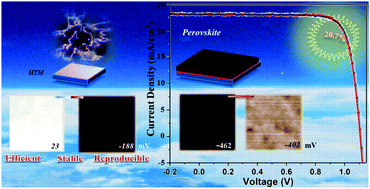20.7% highly reproducible inverted planar perovskite solar cells with enhanced fill factor and eliminated hysteresis†
Abstract
Despite the low-cost and moderate-temperature fabrication process of inverted planar perovskite solar cells (PVSCs), the relatively low efficiency (<20%), inferior reproducibility and poor stability significantly hinder their great potential for future commercialization. To address these issues, here we introduce a novel, economic and efficient hydrophilic group (C–O & C![[double bond, length as m-dash]](https://www.rsc.org/images/entities/char_e001.gif) O) grafted buffer layer (HGGBL) on a non-wetting hole transporting material (HTM) for perovskite formation. This approach of introducing the buffer layer with grafted hydrophilic groups leads to a decrease in the surface potential and surface tension force of the non-wetting HTM, facilitating the nucleation and growth of perovskite crystals. Also importantly, the carbonyl groups tightly bond with the perovskite via Lewis base sites, leading to a dense, smooth, pinhole-free perovskite film with bulk defects being passivated. Benefiting from these merits, the photovoltaic performance is dramatically boosted from 17.42% to 20.75%, which is among the highest efficiencies of inverted planar PVSCs. In addition, the PVSCs with the HGGBL exhibit excellent reproducibility with negligible hysteresis and superior humidity stability. This work validates that the HGGBL is a promising approach for growing perovskite films on non-wetting layers for both high-performance solar cells and other optoelectronic devices.
O) grafted buffer layer (HGGBL) on a non-wetting hole transporting material (HTM) for perovskite formation. This approach of introducing the buffer layer with grafted hydrophilic groups leads to a decrease in the surface potential and surface tension force of the non-wetting HTM, facilitating the nucleation and growth of perovskite crystals. Also importantly, the carbonyl groups tightly bond with the perovskite via Lewis base sites, leading to a dense, smooth, pinhole-free perovskite film with bulk defects being passivated. Benefiting from these merits, the photovoltaic performance is dramatically boosted from 17.42% to 20.75%, which is among the highest efficiencies of inverted planar PVSCs. In addition, the PVSCs with the HGGBL exhibit excellent reproducibility with negligible hysteresis and superior humidity stability. This work validates that the HGGBL is a promising approach for growing perovskite films on non-wetting layers for both high-performance solar cells and other optoelectronic devices.



 Please wait while we load your content...
Please wait while we load your content...